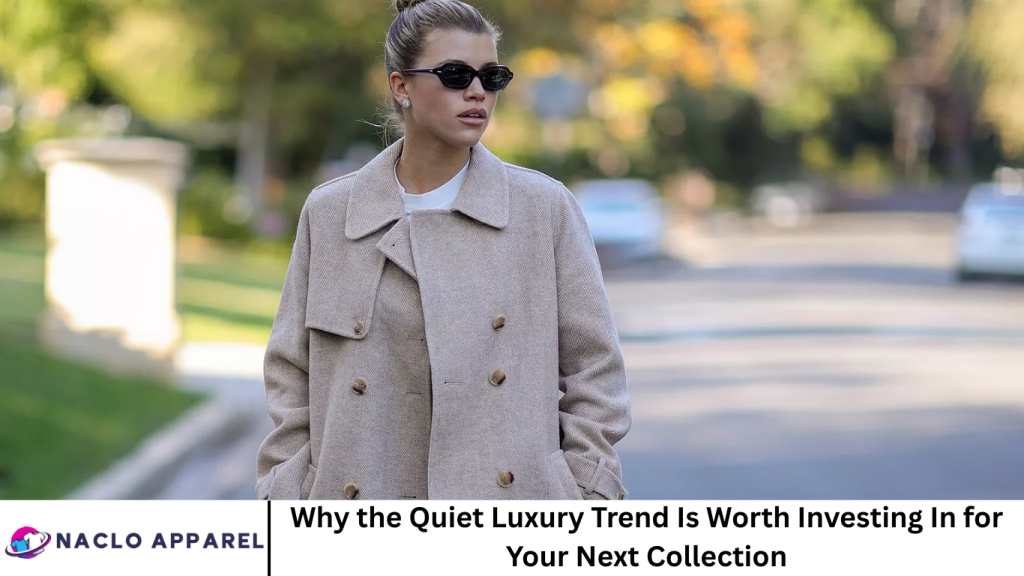In a world that has long equated luxury with logos, flash, and bold declarations of wealth, a new trend is reshaping the fashion industry: quiet luxury. With understated elegance, timeless design, and impeccable craftsmanship, quiet luxury has emerged as the refined response to fast fashion and logo-driven status symbols.
In a fashion world once dominated by loud logos, fast trends, and over-the-top statements, a refreshing shift has quietly taken center stage—quiet luxury. This emerging trend doesn’t shout wealth; it whispers sophistication.
In this article, we’ll explore what quiet luxury truly means, why it’s surging in popularity, how it fits into a changing economic and social landscape, and why designers, brands, and retailers should take it seriously when planning their future collections.
More Read: How to Dress for Cocktail Events: A Complete Guide
What Is Quiet Luxury?
Quiet luxury refers to high-end fashion and lifestyle goods that eschew logos, branding, and ostentatious flair in favor of subtlety, quality, and longevity. Think luxurious cashmere, tailored silhouettes, and neutral palettes made with exquisite attention to detail. It’s the opposite of the “loud luxury” of the 2010s—no giant monograms, no sparkling embellishments—just pure, refined excellence.
Characteristics of Quiet Luxury:
- Minimalism: Clean lines and classic designs.
- Neutral color palettes: Beige, camel, gray, navy, and black dominate.
- Unbranded or subtly branded: Letting the quality speak louder than logos.
- Superior materials: Wool, silk, alpaca, organic cotton, and premium leather.
- Longevity over trends: Items meant to be worn for years, not seasons.
The Cultural Shift Behind the Movement
Quiet luxury isn’t just a fashion choice—it’s a reflection of deeper societal and cultural shifts:
Post-Pandemic Consumer Mindsets
After the upheaval of the pandemic, consumers are re-evaluating their purchases. People now prioritize quality, comfort, and purpose over glitz and trend-chasing. Quiet luxury fits the desire for intentional living.
Economic Uncertainty
In times of inflation and economic instability, flashy displays of wealth can appear tone-deaf. The quiet luxury consumer is affluent but discreet, choosing to invest in wardrobe staples that retain their value and utility.
Sustainability and Conscious Consumption
Quiet luxury dovetails with sustainability. Instead of buying five low-quality garments, today’s consumer wants one impeccably crafted item that lasts. Brands with slow fashion ethics and transparent sourcing stand to benefit.
Quiet Luxury’s Influence in Fashion and Beyond
Quiet luxury isn’t confined to fashion—it’s infiltrating interior design, skincare, hospitality, and lifestyle as a whole. From “stealth wealth” characters in TV shows like Succession to luxury wellness retreats and home minimalism, the message is clear: understatement is the new opulence.
Notable Quiet Luxury Brands:
- The Row – Founded by the Olsen twins, known for ultra-minimal, well-constructed pieces.
- Brunello Cucinelli – Synonymous with soft tailoring and refined palettes.
- Loro Piana – Master of premium textiles like baby cashmere and vicuña.
- Totême, Khaite, and Gabriela Hearst – Emerging leaders in subtle sophistication.
Celebrities Embracing the Trend:
Celebrities like Gwyneth Paltrow, Sofia Richie Grainge, and even Rihanna have made headlines for embracing quiet luxury aesthetics. Sofia’s wedding and wardrobe went viral for being the embodiment of “stealth wealth.”
Why Designers and Brands Should Take Notice
Long-Term Revenue Potential
Quiet luxury isn’t a seasonal fad—it’s a long-term consumer mindset. Collections rooted in quality and timelessness encourage repeat purchases and customer loyalty, boosting customer lifetime value.
Appeals to High-Intent Shoppers
Shoppers looking for quiet luxury tend to be more intentional, loyal, and willing to spend. These buyers value a deep connection with a brand’s philosophy, craftsmanship, and ethics.
Differentiation in a Saturated Market
In a world overflowing with fast fashion and influencer brands, creating a quiet luxury collection sets you apart. It allows you to focus on storytelling, heritage, and authenticity—elements that consumers increasingly value.
Room for Premium Pricing
Quiet luxury allows for higher margins due to premium materials and artisanal construction. The perceived value justifies the cost, creating an aura of exclusivity without the need for blatant status symbols.
Building a Quiet Luxury Collection: Key Considerations
If you’re a designer, entrepreneur, or investor planning your next collection, here’s how to strategically incorporate quiet luxury:
Fabric Is Everything
Use only high-grade materials—think organic silk, extra-fine merino wool, Mongolian cashmere, or Japanese denim. Texture and drape become the silent showstoppers.
Craftsmanship Over Quantity
Choose hand-finishing, clean stitching, and quality tailoring over mass production. Limited editions or capsule collections enhance exclusivity.
Design for Versatility and Timelessness
Create pieces that pair well with each other and work across seasons. Think: a camel wool coat, a tailored white shirt, or minimalist loafers.
Neutral and Sophisticated Color Palettes
Stick to whites, blacks, earthy browns, taupe, ivory, and navy. These colors don’t just look elegant—they transcend trends.
Subtle Branding, If Any
Skip the logos and focus on brand storytelling. Let your lookbook, website, and packaging subtly hint at the quality within.
Elevated Shopping Experience
Quiet luxury extends to how customers engage with your brand. Invest in premium packaging, elevated customer service, and personalized outreach.
Quiet Luxury and Sustainability: A Symbiotic Relationship
Consumers seeking quiet luxury are often drawn to ethical production and sustainable practices. Your collection can amplify this connection by:
- Using natural, biodegradable, or recycled fabrics.
- Highlighting artisanal methods or local craftsmanship.
- Offering repair services or recycling programs.
- Ensuring full supply chain transparency.
Luxury no longer means waste—it means meaningful consumption. Quiet luxury’s emphasis on durability and timelessness aligns perfectly with fashion’s sustainability goals.
Retail Strategies for Quiet Luxury
Whether you’re launching a DTC line or expanding into retail, consider these approaches:
Minimalist Visual Merchandising
Store design and product displays should reflect the brand’s ethos: clean, calm, curated. Let the product speak.
Curated Capsule Drops
Instead of large seasonal drops, opt for smaller, focused collections released periodically to maintain interest and exclusivity.
In-Store Experiences
Offer immersive experiences—personal styling appointments, fabric education events, or slow fashion workshops.
Digital Storytelling
Quiet luxury thrives on narrative. Use your digital presence to tell the story behind your materials, makers, and design philosophy.
Challenges of Quiet Luxury—and How to Overcome Them
While quiet luxury presents many advantages, it’s not without challenges:
- Longer production timelines due to quality sourcing.
- Higher upfront investment in materials and labor.
- Harder to market without visual branding—you’ll rely heavily on storytelling, lookbooks, and earned media.
- Niche audience—but loyal and growing.
To succeed, brands must be patient, purpose-driven, and deeply committed to excellence. It’s about slow, steady growth—not viral hype.
Frequently Asked Question
What’s the difference between quiet luxury and old money style?
Quiet luxury focuses on premium quality and minimalism without obvious status symbols. “Old money style” shares similar aesthetics but emphasizes generational wealth and classic heritage looks. Quiet luxury appeals to both old and new generations of discreet affluence.
Is quiet luxury only for high-income consumers?
While rooted in high-end fashion, quiet luxury can inspire affordable lines that emphasize quality basics and subtle elegance. Brands like COS or Everlane incorporate similar principles at accessible price points.
Which fabrics are best for a quiet luxury collection?
Opt for natural, high-grade fabrics such as cashmere, merino wool, organic cotton, silk, Tencel, and fine linen. Focus on texture, drape, and durability.
How do I market a quiet luxury brand without logos?
Rely on visual storytelling, brand heritage, high-quality photography, detailed product descriptions, and lifestyle narratives. Partner with tastemakers known for understated style.
Can a startup brand succeed in the quiet luxury space?
Absolutely—especially if you emphasize craftsmanship, ethical sourcing, and slow fashion values. While competitive, the space values depth over scale.
How often should I release a quiet luxury collection?
Twice a year is ideal for quiet luxury. You can also adopt a “seasonless” model, releasing smaller capsule collections that stay relevant year-round.
What kind of customer buys quiet luxury?
Typically, these customers are discerning, well-informed, and value authenticity, quality, and longevity. They may not be flashy, but they’re willing to invest in long-term pieces.
Conclusion
Quiet luxury is more than just a fashion trend—it’s a reflection of evolving values, where authenticity, craftsmanship, and intentionality reign supreme. In an age where consumers are craving quality and meaning over noise and excess, investing in a quiet luxury collection is not just aesthetically relevant—it’s financially and ethically sound. As a designer or brand, you have the opportunity to lead this cultural shift and craft pieces that transcend fashion and stand the test of time. Quiet luxury may whisper, but its impact echoes far into the future.


